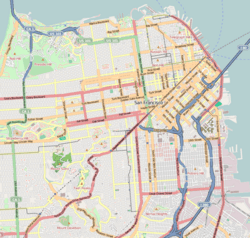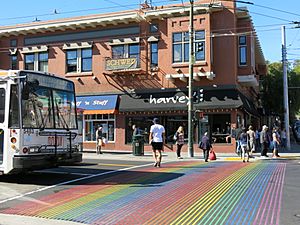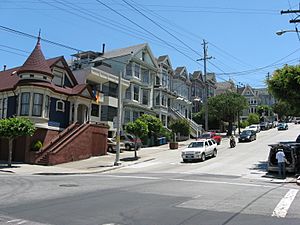Castro District, San Francisco facts for kids
Quick facts for kids
Castro District
|
|
|---|---|
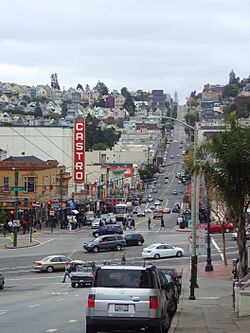
Castro Street, with the Castro Theatre on the left
|
|
| Nickname(s):
The Castro
|
|
| Country | |
| State | |
| City-county | San Francisco |
| Named for | José Castro |
| Area | |
| • Total | 1.36 km2 (0.526 sq mi) |
| • Land | 1.36 km2 (0.526 sq mi) |
| Population | |
| • Total | 12,064 |
| • Density | 8,855/km2 (22,935/sq mi) |
| Time zone | UTC-8 (PST) |
| • Summer (DST) | UTC-7 (PDT) |
| ZIP codes |
94110, 94114
|
| Area codes | 415/628 |
The Castro District, often called the Castro, is a lively neighborhood in Eureka Valley in San Francisco. It became one of the first places in the United States known for its welcoming community for people of all backgrounds. The Castro changed from a working-class area in the 1960s and 1970s. Today, it is a major symbol for fairness and equal rights around the world. It is a place where many people who identify as LGBTQ+ (lesbian, gay, bisexual, transgender, queer/questioning, and others) found a home and a community.
Contents
Exploring the Castro District's Location
San Francisco's welcoming community area is mostly found in the business part of Castro Street. This runs from Market Street to 19th Street. It also stretches along Market Street towards Church Street. The area includes both sides of the Castro neighborhood, from Church Street to Eureka Street.
Many people who identify as LGBTQ+ live in the residential areas nearby. These areas are bordered by Corona Heights, the Mission District, Noe Valley, Twin Peaks, and Haight-Ashbury neighborhoods. Some people also include Duboce Triangle and Dolores Heights, which have many LGBTQ+ residents.
Castro Street starts a few blocks north at Divisadero and Waller Streets. It goes south through Noe Valley, past the 24th Street business area. The street then ends as a continuous road as it moves towards the Glen Park neighborhood. It appears again in smaller parts before finally ending at Chenery Street in Glen Park.
The Castro District's Rich History
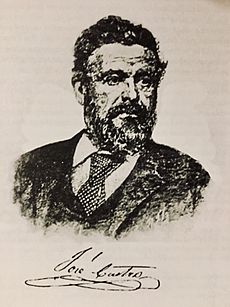
Castro Street got its name from José Castro (1808–1860). He was a leader in California who opposed U.S. rule in the 1800s. He also served as a mayor in Alta California from 1835 to 1836. The Castro neighborhood, located in the Eureka Valley district, was formed in 1887. This happened when the Market Street Railway Company built a train line connecting Eureka Valley to downtown San Francisco.
In 1891, Alfred E. Clarke built his large home at 250 Douglass, at the corner of Douglass and Caselli Avenue. This home is often called the Caselli Mansion. It survived the big 1906 earthquake and fire. That disaster destroyed a large part of San Francisco.
Early Days of the Castro Community
Before the 1900s, the Castro District and nearby areas were known as Little Scandinavia. This was because many people living there came from Finnish, Danish, Norwegian, and Swedish families.
The 1943 book Mama's Bank Account by Kathryn Forbes tells the story of a Norwegian family living in this area in the 1910s. This book inspired a play, a movie, a radio show, and a TV series called Mama. The story showed the Eureka Valley neighborhood where Norwegian families went to church and met for social events.
The Scandinavian Seamen's Mission was located on 15th Street, near Market Street. It was close to the Swedish-American Hall, which is still in the district. In the 1920s, during Prohibition, the downstairs of the Swedish-American Hall was a secret bar. These hidden bars were called speak-easies.
You can still see buildings with Scandinavian-style wood frames along Market Street. These are between Castro and Church Streets. A restaurant called Scandinavian Deli operated for many years on Market Street.
In the 1930s, many Irish, Italian, and other immigrants moved to the Castro. It slowly became a mixed working-class neighborhood. It stayed this way until the mid-1960s. There used to be a cable car line on Castro Street. It ran from Market Street to 29th Street. The tracks were removed in 1941, and a bus line replaced the cable car. The Castro is at the end of the straight part of Market Street. A mostly residential area follows Market Street as it curves up towards the Twin Peaks mountains.
Fun Places to Visit in the Castro
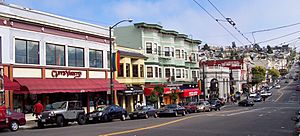
One of the most famous spots in the neighborhood is the Castro Theatre. This movie palace was built in 1922. It is one of San Francisco's best movie houses.
The intersection of 18th and Castro is very important. Many historic events, marches, and peaceful protests have happened there. They continue to happen there today.
A major cultural spot is the GLBT History Museum. It opened in December 2010 at 4127 18th Street. The museum officially opened in January 2011. It is the first full-size museum in the United States dedicated to lesbian, gay, bisexual, and transgender history. It is a project of the GLBT Historical Society.
The F Market heritage streetcar line turns around at Market and 17th Streets, where the Jane Warner city parklet is. Across Castro Street is the Harvey Milk Plaza. This plaza honors its most famous resident, Harvey Milk. It has a giant flagpole with a large rainbow flag, a symbol of the LGBTQ+ community. Below the street is the main entrance to the Castro Street Station, a Muni Metro subway station. Milk's camera store and campaign office at 575 Castro has a special plaque and a mural inside. It now holds an LGBTQ+ arts store. There is also a smaller mural above the sidewalk showing Milk looking down on the street.
Across Market Street from Harvey Milk Plaza, slightly up the hill, is the Pink Triangle Park. This city park and monument is at 17th Street and Market. It is named after the pink triangles that were worn by people persecuted by the Nazis during World War II.
Twin Peaks Tavern is located at the intersection of Market and Castro. It was one of the first community gathering places in the city with large windows. These windows allowed people inside to be seen by the public.
The Hartford Street Zen Center is also in the Castro. So is the Most Holy Redeemer Catholic Church at 100 Diamond Street.
Special events and street fairs happen in the Castro. These include the Castro Street Fair and the Dyke March. The San Francisco International LGBT Film Festival is also held here.
An LGBTQ+ Walk of Fame, called the Rainbow Honor Walk, was created in August 2014. It started with twenty bronze plaques on the sidewalk. These plaques honor past LGBTQ+ heroes who inspire others. The walk was planned to cover the Castro business district. It will eventually have 500 bronze plaques.
The main business part of Castro Street, from Market to 19th Street, was rebuilt in 2014. This work helped with traffic and visitors. The sidewalks were made wider, and new trees were planted. Also, 20 historical etchings were placed in the cement in September 2014. These tell the story of the area from its beginning to the 2010s.
Castro Street History Walk: Learning About the Past
The Castro Street History Walk (CSHW) is a special sidewalk display. It has twenty historical fact plaques about the neighborhood. Ten plaques cover the time before 1776 up to the 1960s, before the Castro became known as a community for LGBTQ+ people. The other ten plaques highlight important events related to the queer community in the Castro. These plaques are found on the 400 and 500 blocks of Castro Street, between 19th and Market streets. They were put in place at the same time as the first twenty Rainbow Honor Walk plaques.
The CSHW facts are in order, starting at Harvey Milk Plaza at Market Street. They go up to 19th Street and then return on the other side of Castro Street. The Castro Business District paid for the CSHW. They worked with local residents and historians to create the facts. Each fact had to be about the neighborhood or the nearby Eureka Valley. The facts are short, with a limit of 230 characters. Each pair of facts has a picture that looks like the historic Castro Theater.
Key Facts from the History Walk
- Pre-1776: The native Yelamu people, a group of Ohlone people from the San Francisco Bay Area, lived here.
- 1776: Juan Bautista de Anza established Mission Dolores.
- 1846: The last Mexican mayor of Yerba Buena (San Francisco) was given the area later called Eureka Valley.
- 1854: John Horner bought some of the ranch land.
- 1895: Better transportation, like the Castro Street cable car, brought working-class Irish, German, and Scandinavian families to settle here.
- 1900: Most Holy Redeemer Church was founded.
- 1907: The Swedish American Hall, a place for music and events, opened.
- 1918: The Twin Peaks Tunnel was built, connecting the neighborhood with West Portal.
- 1922: The famous local architect Timothy Pflueger designed his first theater, the Castro Theatre, which then opened.
- 1935: Hans K Lund, the first owner of The Missouri Mule, opened his business.
- 1943: Local author Kathryn Forbes, who was Norwegian-American, set her novel Mama's Bank Account on Castro Street.
- 1953: After 18 years, Hans K. Lund and his wife Margaret sold The Missouri Mule. Del Martin and Phyllis Lyon, a well-known lesbian couple, made a home on Castro Street.
- 1963: The Missouri Mule was sold again. It closed briefly to expand and reopen under the same name. It became the Castro's first openly welcoming community gathering place. Many LGBTQ+ residents and businesses moved in, changing the area into the Castro we know today.
- 1972: Twin Peaks Tavern, the U.S.'s first community gathering place with open-glass windows, opened.
- 1978: The community gathered by the thousands in the Castro for a candlelight march to remember important leaders.
- 1981: Community activist Bobbi Campbell, also known as Sister Florence Nightmare, put up flyers at the pharmacy about a new health concern.
- 1987: The AIDS Memorial Quilt had its first home on Market Street, thanks to activist Cleve Jones.
- 1998: The Bay Area Reporter newspaper famously printed "No Obits" on its front page, celebrating a time when there were fewer deaths from HIV/AIDS.
The Castro District: A Welcoming Place for Visitors
San Francisco has many popular tourist areas, like Chinatown, North Beach, Haight-Ashbury, and the Castro. The Castro is a successful area that brings in money all year. It has many events for the LGBTQ+ community and everyday businesses.
The Castro is a "busy marketplace for all things related to the LGBTQ+ community." This means the area serves people who identify with LGBTQ+ culture. There are cafes, the Castro Theater, and many businesses that welcome LGBTQ+ customers. These places make the Castro a popular area for spending money and attract many tourists. Besides local people, visitors come to see the shops, restaurants, and events like the Castro Street Fair. Events like the fair help local businesses and bring people from all over the country. They visit just for the special atmosphere the Castro offers.
People who might not feel comfortable expressing themselves in their own communities can travel to places like the Castro. Here, they can feel accepted and free. The district promotes a feeling of belonging and acceptance for non-traditional people. This is why many LGBTQ+ travelers are drawn to the Castro.
The Golden Gate Business Association (GGBA) was started in 1974. It helps promote the Castro as a place for tourists. It also promotes San Francisco and LGBTQ+ businesses in general. The GGBA wanted to gain local political power. They hoped to do this by increasing tourism related to the LGBTQ+ community. In 1983, the association formed the San Francisco Gay Tourism and Visitor's Bureau. The LGBTQ+ tourism industry helps the economy because of the steady flow of visitors.
See also
 In Spanish: Castro (San Francisco) para niños
In Spanish: Castro (San Francisco) para niños


